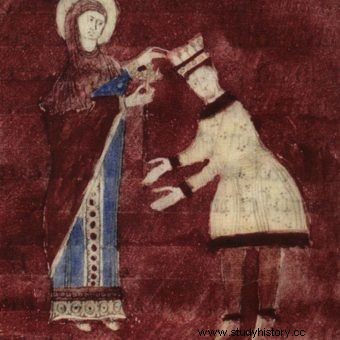
Otto III in a medieval miniature.
Otto III (980-1002)
German King and Emperor of the Ludolfing Dynasty, son of Otto II. He was crowned king as a child of only 3.5 years. On his behalf, the regency was first exercised by mother Teofano, and after her death in 1991, by grandmother Adelaide. He assumed independent power in 995. In 996 he was invited to Rome by John XV, who, however, died before he reached the place. As a successor, Otto III proposed his cousin Bruno, who took the name of Gregory V. It was he who crowned him the emperor in the same year. In 997, Otto III decided to return to Rome to restore Gregory V to the See of Peter and expel the Antipope John Filagatos, or John XVI, from there.
In 1000, the famous Congress of Gniezno took place. It was Otto III's pilgrimage to the tomb of St. Wojciech, as well as a meeting with the prince of Poland Bolesław in the then capital of the state - Gniezno. He had been friends with Bolesław the Brave before, along with whom he undertook joint military expeditions against pagans. His friend was also St. Wojciech, who died during the expedition of 997 and whose grave he later visited. During the convention, Otto III put a tiara on the head of the Polish prince, and gave him a copy of the spear of St. Maurice and a nail from the Lord's Cross, exempting him from paying tribute at the same time. At that time, an archbishopric was also established in Gniezno with subordinate bishoprics in Kraków, Wrocław and Kołobrzeg.
Otto III is credited with the project of renewing the Roman Empire, which he wanted to implement in cooperation with, inter alia, with Poland and Hungary. For example, he consented to the coronation of Stefan Węgierski. At the end of 1001, he prepared a military expedition to Rome to suppress the revolt that had broken out against him there. However, he died during this trip in early 1002, possibly of malaria.
